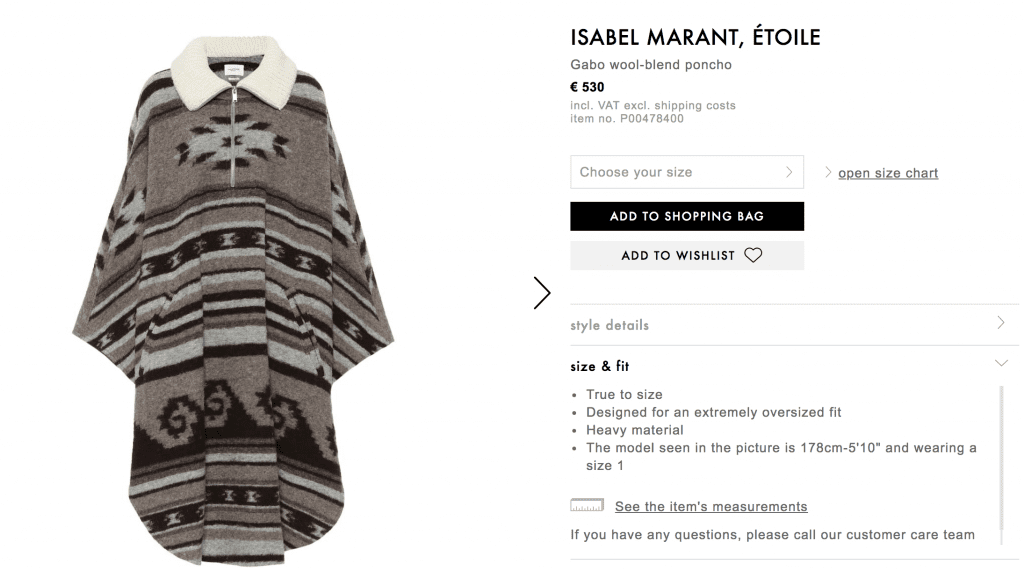Isabel Marant has apologized after being called for “appropriating” a traditional indigenous pattern. On the heels of Mexican Culture Minister Alejandra Frausto Guerrero alleging that Isabel Marant co-opted a pattern unique to the Purepecha community for a $695 cape, the Paris-based brand has issued a formal apology, with its eponymous founder saying in a letter dated November 6 that she is “enormously saddened” and that she had intended the design to “promote a craft and pay tribute to the aesthetic to which it is linked.”
Ms. Marant – whose 26-year old namesake label has been deemed responsible for “defining modern Parisian cool,” as the New York Times put it this summer – continued on to state that “if the Isabel Marant house and the designer have disrespected the Purepecha community… they implore you, and the country you represent, to accept their most sincere apologies.” She noted, as previously reported by the BBC, that the brand’s future designs will “pay tribute to our sources of inspiration.”
In response to Marant’s letter, Frausto Guerrero asserted that Marant had not sought or received authorization from the Purepecha community before offering up her printed Gabin cape, which has since been pulled from the brand’s e-commerce website but remains on the sites of the brand’s third-party stockists, including Farfetch, Mytheresa, and Tiziana Fausti. “When a tribute is made to a certain culture, that culture should be included, because although it may be an ancestral culture, it is alive,” she stated, and the communities at issue “should be able to decide whether” or not they want to engage in such a partnership.
The matter – which was handled exclusively between the Marant brand and the culture arm of the Mexican government (and thus, not in court) – falls outside of the bounds of copyright law, the type of law that would normally protect the original prints and patterns that appear on garments and accessories. Instances of cultural appropriation commonly exist beyond the realm of copyright law and other forms of intellectual property (with some exceptions) because the designs at issue are routinely associated with certain communities as a whole, and in many cases, date back by tens – if not hundreds – of years, which clashes with the notions of individual authorship/ownership and limited duration for protection that are at the heart of traditional intellectual property laws.

With that in mind, and as New York University Law School professor Christopher Sprigman previously told TFL, if there is an appropriate avenue for calling foul on brands like Isabel Marant in connection with such controversial products, it is likely more squarely with existing efforts to protect “traditional knowledge.” (Legislative bodies, courts, and non-governmental organizations, such as the World Intellectual Property Organization, have been examining issues related to – and legal frameworks that might be suitable for protecting – traditional knowledge, discussions that have spanned years and continents and that have spawned varied results).
As for Isabel Marant, who was offerings up “Navajo” trousers as recently as S/S 2020, this is not the first time that the brand has been accused of misappropriation. In 2015, Ms. Marant and her brand came under fire in connection with an embroidered top, which allegedly hijacked a design from and ran afoul of the rights of Mexico’s indigenous Tlahuitoltepec community. While Marant and Mexican officials managed to settle the dispute over Marant’s copycat version of the “huipil” blouse between themselves, the matter took an interesting turn when French fashion brand Antik Batik sued Marant over the very same top, claiming rights in the design. According to the complaint that it filed with a French court, Antik Batik asserted that Marant was infringing its copyright by way of the blouse, and sought monetary damages as a result.
Speaking about the legal battle at the time, Marant’s lawyer Jean-Marc Felzenszwalbe told WWD, “Antik Batik has filed a lawsuit against Isabel Marant, claiming the property of this specific design. They claim they have created it and that Isabel Marant is counterfeiting it, which is all wrong.” As for allegations that Marant had also claimed rights in the design of the top, which first appeared in the brand’s Spring/Summer 2015 collection, Felzenszwalbe stated, “We have made it very clear in court that we are not claiming any property [rights] and that these designs come from the village of Santa María in Mexico.”
A civil court in Paris eventually determined that “neither Isabel Marant nor Antik Batik could [claim] rights in huipil shirts because they are a cultural artefact of the Mixe people,” and ordered Antik Batik to pay upwards of $3,000 to cover Marant’s legal fees.
The matter at hand comes amid past claims from the Mexican culture ministry, which accused both Carolina Herrera and Louis Vuitton of appropriating traditional prints for pricey garments and in Louis Vuitton’s case, furniture, last year.











